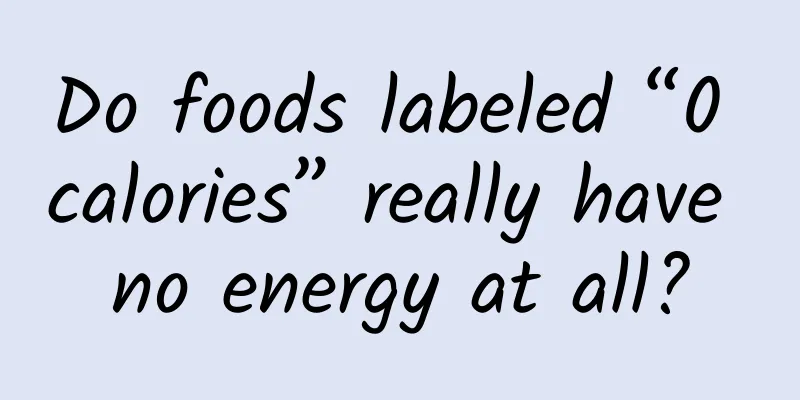Do foods labeled “0 calories” really have no energy at all?

|
As the weather warms up, have the weight loss army started to work again? As the saying goes, "70% of weight loss depends on diet and 30% on exercise." When losing weight, everyone should eat less. Some people (like me) even download apps to record the food and amount they eat every day and calculate calories. Image source: Screenshot of an APP So, how are calories calculated? Can you eat foods labeled "0 calories" without worrying about eating them? Today, let's uncover the mystery of calories. 01 How are food calories measured? The word calorie comes from the Latin word calere, which means to heat up. It was introduced into scientific terminology as early as the well-known Lavoisier . Lavoisier overturned the phlogiston theory, named oxygen, and discovered that the principle of breathing and combustion consuming oxygen is the same, but he probably didn't expect that calories would become an important indicator in the struggle of modern people to lose weight. Image source: "Lavoisier and his Wife" oil painting There are two main methods to measure food calories, namely the direct method and the indirect method. (1) Direct method The direct method, also known as the direct combustion method, requires a professional calorimeter. The main components of the calorimeter are the combustion chamber and the water around the combustion chamber. The food sample to be tested is placed in the combustion chamber for complete combustion. The energy released by the combustion of the food will cause the surrounding water to heat up. At normal temperature and pressure, each milliliter of water needs to absorb about 1 calorie of energy for every 1 degree Celsius increase in temperature. Therefore, as long as the degree of water increase is measured, the calories per unit weight of food can be calculated. However, this method is relatively complicated, has high requirements for instruments, and is rarely used. (2) Indirect method The indirect method, also known as the calculation method, is the method used to calculate the energy of food in the Chinese Food Composition Table. At the end of the 19th century, American chemist Wilbur Olin Atwater calculated the calories of the three major macronutrients (protein: 4 kcal/g, fat: 9 kcal/g, carbohydrates: 4 kcal/g) by burning different nutrients. Therefore, you only need to multiply the gram weight of each energy-supplying nutrient by the corresponding energy conversion coefficient and then add them up to indirectly calculate the calories of the food. Atwater's device measures calories burned from food and exercise Image source:syourdoctorsorders.com 02Do foods labeled “0 calories” really have no energy at all ? According to the National Food Safety Standard - General Rules for Nutrition Labeling of Prepackaged Foods (GB 28050-2011), solid foods with an energy content of ≤17 kJ/100 g and liquid foods with an energy content of ≤17 kJ/100 mL can be claimed to be “energy-free”[1]. The synonym of “no” is “zero (0)”, so “0-calorie” foods refer to foods with extremely low or almost no energy. Although “0-calorie” foods are not necessarily absolutely energy-free, even if they contain energy, the energy is almost negligible (17 kJ is approximately equal to 4 kcal). Source: National Food Safety Standard - General Rules for Nutrition Labeling of Prepackaged Foods (GB 28050-2011) Those who have been trying to lose weight for a long time may find that some of the so-called "0-calorie" foods are tasteless, while others are very sweet. What's going on? In fact, non-sweet "0-calorie" foods generally include water/beverages without added sugar, high-fiber vegetables or fruits and their products, etc., while sweet "0-calorie" foods are generally non-sweet "0-calorie" foods with sugar substitutes added. Sugar substitutes have a sweet taste, but compared to sugar, they have very low energy or no energy. Synthetic aspartame Source: Foodie Research Institute 03 When losing weight, can you eat “ 0-calorie ” foods safely? ( 1 ) Non-sweet “0-calorie” foods can When losing weight, "0-calorie" and non-sweet foods are a good choice. These foods are very friendly to people who are losing weight. They usually contain lower energy, help control overall energy intake, and are rich in dietary fiber, which can increase satiety and help reduce the possibility of overeating. ( 2 ) Sweet “zero-calorie” foods are not recommended For "0-calorie" foods with added sugar substitutes, although sugar substitutes themselves do not provide energy, their effects on the human body are multifaceted. Excessive consumption of sugar substitutes may make the brain mistakenly believe that the body has taken in sugar and secrete insulin as a result. This phenomenon is called "cephalic phase insulin release", but in fact there is no glucose. Over time, the signal for the body to secrete insulin will become disordered, which also increases the risk of chronic diseases such as obesity and diabetes . A large number of population studies have shown that weight control with sugar substitutes is more theoretical and may also produce small benefits in obese diabetic people; for the general population, long-term consumption of sugar substitutes may increase the desire for sweets and drinks, leading to obesity [2]. The guidelines issued by the World Health Organization also do not recommend the use of sugar substitutes to control weight. Image source: Photo Network In fact, calories are not our enemy. They are just reminding us to maintain balance and self-discipline. Even if we want to lose weight, we don’t have to demonize calories. Losing weight requires a comprehensive consideration of factors such as diet, exercise and lifestyle. The best way is to develop a balanced diet plan that includes all kinds of food, such as protein, healthy fats, whole grains and other fruits and vegetables to ensure that you can stay healthy while losing weight. References [1] Liu Ding, Ge Yu. GB7718-2011 National Food Safety Standard General Rules for Prepackaged Food Labeling[D]. , 2012. [2] Pang MD, Goossens GH, Blaak E E. The impact of artificial sweeteners on body weight control and glucose homeostasis[J]. Frontiers in nutrition, 2021, 7: 333. Author: Wang Zhengyuan, PhD in Nutrition, Deputy Chief Physician, Shanghai Center for Disease Control and Prevention Planning & Editing: Ding Dong Title image source: Photo Network, Gaoding Design |
<<: Can controlling your diet cure gout? 6 common rumors, all explained
>>: Open-back headphones are comfortable to wear for long periods of time
Recommend
What are the precautions after induced labor?
Nowadays, many young women often undergo induced ...
6 “depths” of social media and digital marketing in 2022
Competition in the video space is getting fiercer...
How long after ligation recanalization can I have sex?
Many couples undergo ligation for contraception, ...
Heavy menstrual flow with blood clots after IUD insertion
What is the reason for heavy menstrual flow and b...
Is it normal to have stomach pain after medical abortion?
Medical abortion is a relatively popular method o...
What does Guyu eat? Red-billed green parrots!
Author: Fluent Grain Rain is the last solar term ...
Reasons for discomfort in women
The lower part of a woman is what we often call t...
Can pregnant women use Shuangfeiren potion for toothache?
Toothache is very common to everyone, and as we o...
What should women drink to make their complexion better?
Female friends nowadays are troubled by work and ...
Will insomnia in pregnant women affect the sleep of the fetus?
There are more and more people suffering from ins...
TrendForce: Gaming LCD monitor shipments reached 8.5 million units in 2019
According to the latest survey by TrendForce’s Op...
The harm of two consecutive months of abortion
Nowadays, advertisements about abortion are every...
Standardization study on exercise rehabilitation and functional training in geriatric general medicine
In general geriatric medicine, exercise rehabilit...









